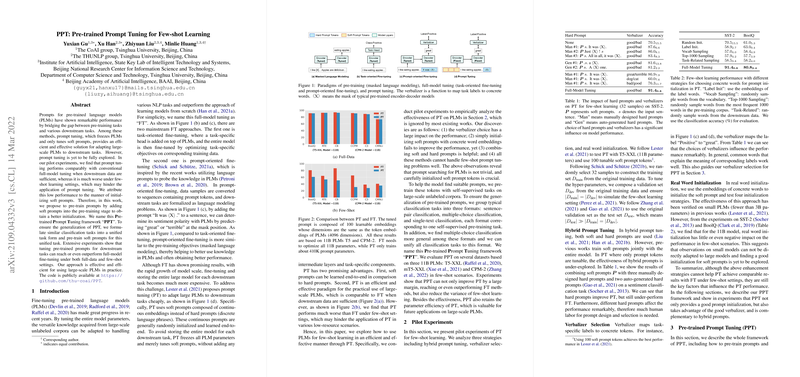Analyzing the Potential of Pre-trained Prompt Tuning for Few-shot Learning
The paper, "PPT: Pre-trained Prompt Tuning for Few-shot Learning," presents a novel approach designed to enhance the efficacy of prompt tuning, particularly in the context of few-shot learning scenarios using pre-trained LLMs (PLMs). This work addresses a critical shortcoming in conventional prompt tuning methodologies, wherein initializing soft prompts poses challenges, especially when data scarcity is prevalent.
Key Concepts and Methodology
Prompt tuning (PT) has emerged as an efficient method for adapting PLMs to downstream tasks by employing tunable soft prompts rather than tuning the entire model. Despite its advantages in scenarios with abundant data, PT demonstrates inferior performance under few-shot conditions. The authors attribute this limitation primarily to inadequate initialization of soft prompts.
The paper introduces Pre-trained Prompt Tuning (PPT) as a solution, which involves incorporating soft prompts during the original pre-training stage of PLMs. By establishing a pre-trained foundation, the PPT framework seeks a more robust initialization for soft prompts, consequently enhancing task-specific performances. To guarantee general applicability, a unified task form is developed, classifying tasks into three main types: sentence-pair classification, multiple-choice classification, and single-text classification. Each category is associated with a dedicated pre-training task to pre-train soft prompts effectively.
Empirical Evaluations
The paper reports extensive experimental evaluations across several datasets and PLMs, notably T5-XXL, mT5-XXL, and CPM-2. Results exhibit that by using the proposed PPT approach, the performance of prompt tuning aligns closely, and in certain cases, even surpasses that of full-model tuning. This achievement is consistent under both full-data and few-shot settings.
Quantitatively, the paper highlights that PPT not only enhances accuracy metrics but also shows lower variance in learning outcomes across various tasks. For instance, in sentiment classification and natural language inference tasks, PPT significantly outperformed traditional PT methods. The results support the hypothesis that well-initialized prompts via pre-training serve as a pivotal factor in achieving superior outcomes in few-shot learning scenarios.
Theoretical and Practical Implications
The theoretical impact of this work lies in its potential to redefine how large-scale PLMs can be practically employed across different NLP applications. By pinpointing and addressing the limitations inherent in prompt tuning related to soft prompt initialization, the authors propose a more resilient approach adaptable to varied data conditions.
From a practical standpoint, the PPT framework offers a compelling alternative to full-model tuning, particularly where computational resources are constrained. This method allows efficient storage and use of large-scale PLMs, thus proving invaluable when scaling models to numerous tasks without extensive retraining.
Future Prospects
The PPT framework sets a precedent for future research avenues in two fundamental ways. First, it opens up possibilities for expanding this approach to other domains and task types beyond classification, including generative tasks and multilingual contexts. Second, the methodology can inform enhanced techniques in training PLMs by incorporating self-supervised pre-training stages that better align with downstream applications.
In conclusion, the paper presents a well-founded, empirically-backed approach to prompt tuning that offers meaningful contributions to the field of few-shot learning. By leveraging pre-trained prompts, it not only advances the effectiveness of PT but also provides a scalable, resource-efficient solution that stands resilient across both data-scarce and data-rich scenarios.
